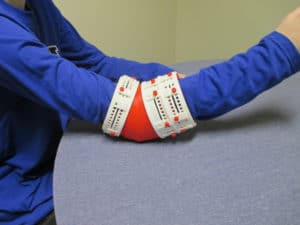Last week, AM News profiled the 2018 Stratasys/GrabCAD 3D Printing Extreme Redesign Challenge. We highlighted the details of the 3D printing challenge so students (and educators) could consider entering the contest. But in this post, we want to highlight the seven winners from 2017 to acknowledge their success and look at what they created as inspiration for this year.

Take a look at what the 2017 Extreme Redesign winners created (photos and general information from the challenge website used with permission from Stratasys):
1st Place: Biomimetic Robotic Prosthetic Hand
Grayson Galisky from Los Alamitos High School (CA)
Since he began 3D printing four years ago, 18 year old Grayson Galisky has been perfecting his craft by completing many different projects, and even building his own 3D printers… By modeling his design with major human hand components, he created more life-like features with regard to movement and speed. Galisky made innovations in the control department as well by using draw-wire sensors to collect data from his own hand movements to send to the robotic hand. Read more about the Biomimetic Robotic Prosthetic hand project here.
2nd Place: Bidirectional Ratchet
Connor Meehan from Saline High School (MI)
A problem solver at heart, Connor Meehan is an engineer who uses 3D printing to solve problems people in his life are facing. In particular, an arthritis problem his grandfather, who loves working on cars, is facing fueled the inspiration behind his bidirectional ratchet… Meehan wanted to invent a way for his grandpa to continue the automotive work he enjoyed without suffering from the stress on his joints. Thus, the bidirectional ratchet was created. Read more about the Bidirectional Ratchet here.
1st Place: Adjustable, Reusable and Modular (ARM) Cast
Thomas Salverson from University of Alabama in Huntsville (AL)
Although Thomas Salverson has no plans to be a doctor, he managed to create a new way to care for broken arms with his adjustable, reusable and modular (ARM) Cast. After being exposed to 3D printing through his high school rocketry team, Salverson started seeking out other ways he could exercise his 3D printing skills. The ARM casts consists of a modular ring, adjustable pads and an elbow joint, all which can be detached and then put together on the arm. Check out this innovative new Adjustable, Reusable and Modular (ARM) Cast here.
2nd Place: Fender Lock
Matthew Wong & Luis Carvalheiro from Ryerson University (Ontario, Canada)
A friend’s stolen bike seat and one 3D printing competition later, Matthew Wong and Luis Carvalheiro created a full-proof way to make sure bike seats never leave the bike they’re attached to again. After learning of the Extreme Redesign Challenge from their teacher, they soon started thinking of problems they could solve and remembered the story of their friend’s stolen bike seat. So they created the Fender Lock — more than just a lock, it includes a retractable fender to prevent your back from getting dirty and a convenient bottle opener as well. Read more about the 3D printed Fender Lock here.
1st Place: Intricate Flower Centerpiece
Daniel Fahy from University of Oxford/St.Catherine’s College (Oxfordshire, UK)
Daniel Fahy is fascinated by the unique, crazy designs you can make with 3D printing and as an engineer, he’s someone who likes to do it himself. Fahy was interested in the Extreme Redesign Challenge because of design freedom, and the limitless capabilities of 3D printing, which shows in his intricate flower piece. With his design, Fahy’s goal was to make a functional piece of art to show the endless possibilities 3D printing has to offer. His design uses zinnia and dahlia flowers for inspiration, which symbolize remembrance, represented by the candle function, and a lasting bond between two people, represented by the jewelry box. Read more about the Intricate Flower Centerpiece functional art project.
2nd Place: Khachkar – Armenian Cross Stone
Sergey Kuznetsov from J-Design Pro (Saint Petersburg, Russian Federation)
Sergey Kuznetsov is a creator. As a sound engineer and video jockey for more than 20 years, Kuznetsov started looking for other avenues to exercise his creativity. In his search for something new, he found 3D printing and admired the way that people were able to express themselves through the models they make. After dedicating himself to learning it and enrolling in design school, he 3D printed a khachkar, an Armenian outdoor stele. Kuznetsov’s inspiration to make a khachkar came because of its symbolism and beauty. Read more about the Khachkar Armenian Cross Stone project.
NCATC School Winner: Universal Tablet Holder for Phantom Drone 3
Jacob Haynes from Danville Community College (VA)
Jacob Haynes does his best to 3D print every day. Since discovering 3D printing at his technical high school, he’s constantly using the 3D printer at Danville Community College to make new things. One of those things was a universal tablet holder for Phantom Drone 3. It improves upon traditional drone holders with a bigger surface for cameras, since most only have a platform that is big enough for a phone. This design was originally made for a class project, but Haynes’ teacher liked his design so much he suggested Haynes’ enter it into the Extreme Redesign Challenge. Read more about the Universal Tablet Holder for Phantom Drone 3 project.